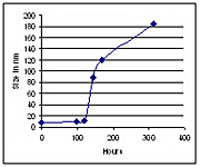

The study of protein aggregation encompasses a broad range of interactions and mechanisms. Many studies into this subject area investigate the aggregation of misfolded proteins, which is thought to be responsible for many degenerative diseases. Since aggregation typically leads to a physical change in protein size, particle size analysis has proven to be a useful experimental technique in this field. Although dynamic light scattering (DLS) is widely used to characterize proteins in many instances the aggregates are too large to be reliably measured by that technique. The LA-960 laser diffraction particle size analyzer possesses the unique ability to measure from 10 nanometers to 5 millimeters, accurately detecting the aggregates and, in some cases, the primary protein size.
Of particular interest to protein scientists is to quantify the size, volume, and number of aggregates in a particular material. The LA-960 particle size analyzer provides accurate measurement of size and volume for aggregates between 10 nanometers and 5 millimeters at ultra-low concentrations for traditional laser diffraction devices.
An example result is shown in the figure below using material from the U.S. FDA.
Example data showing primary protein size and aggregates above 1 micron. Results acquired with the LA-960.

Many different types of studies are possible with a dynamic light scattering instrument such as the SZ-100 Nanoparticle Analyzer. Again, because aggregation can typically be detected by changing size results the SZ-100 is useful for aggregates smaller than a certain critical size where Brownian motion still dominates gravitational settling. Additional studies may be carried out with the SZ-100 to characterize how factors such as temperature, pH, salinity, surfactant, and time affect protein folding.
Dynamic light scattering (DLS) is now widely used to study protein aggregation as described in the application notes below.
Nanoparticle Analyzer
Laser Scattering Particle Size Distribution Analyzer
Simultaneous Multi-Laser Nanoparticle Tracking Analysis (NTA)
Do you have any questions or requests? Use this form to contact our specialists.